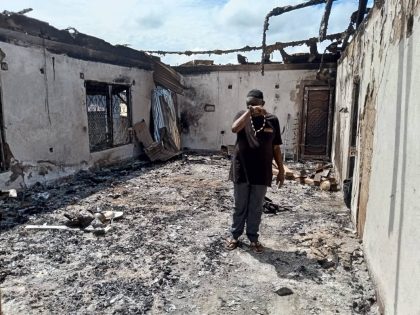Death Metal in Angola
A review of a film on a metal genre produced by young Angolans in Huambo, the center of the protracted civil war that ended in 2002.

Still from "Death Metal Angola."
In case you thought kuduro is all Angola’s music scene has to offer, you were wrong. Although Angolan death metal is nowhere near as popular as the dance and music style kuduro, it has a place in the nation’s fabric. Death metal is no less Angolan (and African) than kuduro, and in dealing with the country’s war-torn past it shapes Angolan identity, much like kuduro does. This is what we learn from Jeremy Xido’s film “Death Metal Angola,” a beautifully shot film that has already been called a “cult classic,” documenting the hopes and dreams of young Angolans in Huambo, the center of the protracted civil war that ended in 2002, while telling the story of this unlikely subculture. The film premiered at the Dubai International Film Festival last December and will be shown at the Rotterdam Film Festival on January 28 and 29. Here‘s the trailer.
The film benefits greatly from the close relationship that the New York-based producer and director Jeremy Xido built up to Sonia Ferreira and Wilker Flores, an Angolan couple that runs an orphanage on the outskirts of Huambo. The documentary follows the couple’s efforts to realize their dream to put on Angola’s first rock festival—“a little Woodstock” in Huambo. This gives the film its overall frame. At the film’s core though is the link between Huambo’s violent past and its future, embodied in the moving story of Sonia. A rock fan, she started her orphanage during the war and now takes care of 56 children. Still shots of Huambo’s war ruins and fading murals are interspersed with clips of interviews with Sonia, Wilker, children from the orphanage, and musicians as well as scenes from the orphanage and band rehearsals. While Sonia’s stories and the ruins speak of the human suffering that the town has seen in the past, the orphanage sheds more hopeful light on life in Huambo. The motto “nos somos o futuro”—“we are the future”— is painted on one of its walls. As the movie fades to the credits, the kids put on an air guitar contest for the film crew.
Death metal is a way to deal with the past, as the musicians tell us in passionate statements: “Our music, because it’s aggressive, can talk about the battles that Angola experienced,” a member of the band Before Crush explains. Hardcore provides freedom of expression like no other music style—“it sounds so true, and it’s the truth we’re after,” Sonia states. “It’s a small revolution we are making here.” The music is, however, not only about the past—it is about the things that “continue even today,” another Before Crush member points out. The film treats these current challenges less bluntly than it does past suffering. Her devotion to the death metal culture helped Sonia, who growing up witnessed domestic abuse around her, pursue a life as an independent woman. We also witness the arrival of a young boy who had to flee from his stepmother after the death of his father, and Sonia’s dealing with an orphan’s girlfriend’s unwanted pregnancy. These intimate insights into people’s lives in Huambo make the film much more than a music documentary.
In spite of the positive outlet that death metal provides for the musicians, rock is not yet well accepted among Angolans. For some, we learn, death metal is too “brutal,” so they prefer the upbeat sound and esthetics of kuduro. Kuduro emerged as a “celebration of being alive” and an emphasis on the positive during wartime, while death metal with its guttural screams and dark lyrics confronts mortality. However, Angolan hardcore is probably more “brutal” than the people performing it—and this is what sparked the filmmaker’s interest. While rivalries between the shantytowns in which kuduro is produced are part of kuduro culture, the film portrays the world of Angolan hardcore as one in which only the music and the lyrics count. Style is marginally important, and the bands (seek to) belong to one big family. “Individually we won’t make it,” says the founder of the Angolan Association of Rock and bassist of Instinto Primário, Yuri Almeida.
The festival seeks to change the hesitant attitude towards death metal and promote rock music among Angolans. With limited resources and power outages, the festival finally starts with a five-hour delay and a small audience. TV footage from its second rendition in the year following the filming of the documentary shows, however, what a success story Sonia and Wilker’s efforts turned into. The film convinces with the power of its protagonists, the thoughtful interviews, and stunning shots, and should be watched by anyone interested in current Angola, not only those in music and popular culture.
- You can listen to Christian Frederickson’s official soundtrack of the film here.



















